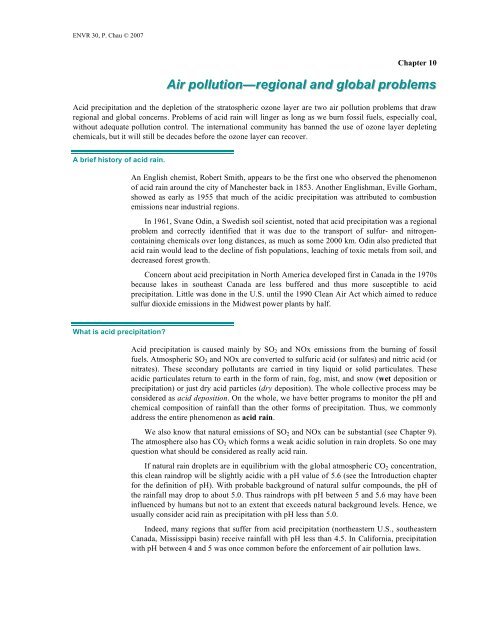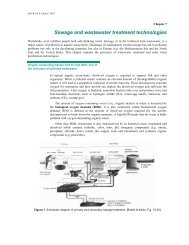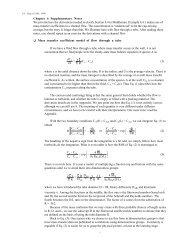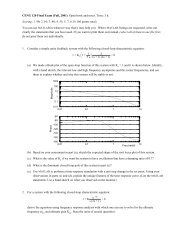Acid rain and ozone layer depletion
Acid rain and ozone layer depletion
Acid rain and ozone layer depletion
Create successful ePaper yourself
Turn your PDF publications into a flip-book with our unique Google optimized e-Paper software.
ENVR 30, P. Chau © 2007<br />
Chapter 10<br />
Aiir polllluttiion—regiionall <strong>and</strong> glloball probllems<br />
<strong>Acid</strong> precipitation <strong>and</strong> the <strong>depletion</strong> of the stratospheric <strong>ozone</strong> <strong>layer</strong> are two air pollution problems that draw<br />
regional <strong>and</strong> global concerns. Problems of acid <strong>rain</strong> will linger as long as we burn fossil fuels, especially coal,<br />
without adequate pollution control. The international community has banned the use of <strong>ozone</strong> <strong>layer</strong> depleting<br />
chemicals, but it will still be decades before the <strong>ozone</strong> <strong>layer</strong> can recover.<br />
A brief history of acid <strong>rain</strong>.<br />
An English chemist, Robert Smith, appears to be the first one who observed the phenomenon<br />
of acid <strong>rain</strong> around the city of Manchester back in 1853. Another Englishman, Eville Gorham,<br />
showed as early as 1955 that much of the acidic precipitation was attributed to combustion<br />
emissions near industrial regions.<br />
In 1961, Svane Odin, a Swedish soil scientist, noted that acid precipitation was a regional<br />
problem <strong>and</strong> correctly identified that it was due to the transport of sulfur- <strong>and</strong> nitrogencontaining<br />
chemicals over long distances, as much as some 2000 km. Odin also predicted that<br />
acid <strong>rain</strong> would lead to the decline of fish populations, leaching of toxic metals from soil, <strong>and</strong><br />
decreased forest growth.<br />
Concern about acid precipitation in North America developed first in Canada in the 1970s<br />
because lakes in southeast Canada are less buffered <strong>and</strong> thus more susceptible to acid<br />
precipitation. Little was done in the U.S. until the 1990 Clean Air Act which aimed to reduce<br />
sulfur dioxide emissions in the Midwest power plants by half.<br />
What is acid precipitation<br />
<strong>Acid</strong> precipitation is caused mainly by SO 2 <strong>and</strong> NOx emissions from the burning of fossil<br />
fuels. Atmospheric SO 2 <strong>and</strong> NOx are converted to sulfuric acid (or sulfates) <strong>and</strong> nitric acid (or<br />
nitrates). These secondary pollutants are carried in tiny liquid or solid particulates. These<br />
acidic particulates return to earth in the form of <strong>rain</strong>, fog, mist, <strong>and</strong> snow (wet deposition or<br />
precipitation) or just dry acid particles (dry deposition). The whole collective process may be<br />
considered as acid deposition. On the whole, we have better programs to monitor the pH <strong>and</strong><br />
chemical composition of <strong>rain</strong>fall than the other forms of precipitation. Thus, we commonly<br />
address the entire phenomenon as acid <strong>rain</strong>.<br />
We also know that natural emissions of SO 2 <strong>and</strong> NOx can be substantial (see Chapter 9).<br />
The atmosphere also has CO 2 which forms a weak acidic solution in <strong>rain</strong> droplets. So one may<br />
question what should be considered as really acid <strong>rain</strong>.<br />
If natural <strong>rain</strong> droplets are in equilibrium with the global atmospheric CO 2 concentration,<br />
this clean <strong>rain</strong>drop will be slightly acidic with a pH value of 5.6 (see the Introduction chapter<br />
for the definition of pH). With probable background of natural sulfur compounds, the pH of<br />
the <strong>rain</strong>fall may drop to about 5.0. Thus <strong>rain</strong>drops with pH between 5 <strong>and</strong> 5.6 may have been<br />
influenced by humans but not to an extent that exceeds natural background levels. Hence, we<br />
usually consider acid <strong>rain</strong> as precipitation with pH less than 5.0.<br />
Indeed, many regions that suffer from acid precipitation (northeastern U.S., southeastern<br />
Canada, Mississippi basin) receive <strong>rain</strong>fall with pH less than 4.5. In California, precipitation<br />
with pH between 4 <strong>and</strong> 5 was once common before the enforcement of air pollution laws.
10–2<br />
The source of acid precipitation <strong>and</strong> controversy.<br />
We know that the cause of anthropogenic emission of SO 2 <strong>and</strong> NOx is predominantly<br />
combustion of fossil fuels. Since about two-thirds of the acidity of the precipitate is due to<br />
sulfuric acid <strong>and</strong> about three-fourths of the SO 2 comes from coal-fired power plants, a<br />
significant amount of acid precipitation would be attributed to these utility plants. In<br />
particular, coal-burning power plants that have no emission control except for a huge smoke<br />
stack (500 to 1,000 feet tall) would be a prime culprit for the amount of SO 2 released. Similar<br />
situations also exist in many eastern <strong>and</strong> western European countries.<br />
However, the location of the power plants can be hundreds of miles away from the<br />
impacted areas. Unfortunately, regulatory agencies have the burden of proof, <strong>and</strong> a key issue<br />
in acid <strong>rain</strong> is the exact source of emissions that ultimately impacts a given area as acid<br />
deposition. The determination of the cause-effect (or source-receptor) relationship involves<br />
two important elements: (1) identification of the trajectories of an air current that arrives at the<br />
deposition location, <strong>and</strong> (2) prediction of the chemical composition of the pollutant based on<br />
the suspected source. To establish a causal link when the impact area is hundreds of miles<br />
away is a formidable task. It took years of measurements, experimentation, <strong>and</strong> computer<br />
modeling before scientists finally established a strong legal case to link SO 2 <strong>and</strong> NOx<br />
emissions to their environmental impacts.<br />
Not all lakes are born equal! Presence of<br />
limestone provides buffering capacity.<br />
One early controversy was that many areas were not affected equally. For example, lakes in<br />
southeast Canada are more susceptible to acid <strong>rain</strong> than lakes in northeast America. The<br />
reason lies in the buffering capacity offered by limestone.<br />
Alkaline soils that are rich in limestone can neutralize acid. When limestone (CaCO 3 ) is<br />
present in the soil or bedrock, it reacts with acid (hydrogen ion H + ) to form bicarbonate ion:<br />
H + + CO 2– –<br />
3 —> HCO 3<br />
The bicarbonate ion can further react with acids to form the weak bicarbonate acid (H 2 CO 3 ):<br />
H + + HCO – 3 —> H 2 CO 3<br />
Moreover, bicarbonate ions (HCO – 3 ) may also be present in natural waters to help neutralize<br />
acids. As long as there is excess limestone, the pH in the aquatic ecosystem is fairly stable,<br />
despite acid <strong>rain</strong>.<br />
Hence, the acid-neutralizing capacity of the lake buffers it against large changes in pH.<br />
Of course, the size, depth, <strong>and</strong> the d<strong>rain</strong>age of a lake (geology, vegetation, water flow) also<br />
influence the ultimate response of the lake to acid <strong>rain</strong>. Once the limestone has reacted with<br />
acid, it is removed from the soil. As soon as the limestone or the source of bicarbonate ions is<br />
depleted, the buffering capacity is lost <strong>and</strong> the pH now drops precipitously with the addition<br />
of acid precipitation. (This is very much like doing titration in your chemistry lab <strong>and</strong><br />
overshooting the end-point.) Indeed, sudden or rapid collapse of lakes <strong>and</strong> forests has been<br />
observed.<br />
Now back to the Northeast region of America, the lakes in Canada are lined with thin soil<br />
<strong>and</strong> glacial granitic bedrock <strong>and</strong> their buffering capacity can be exhausted quickly. In contrast,<br />
the lakes in America tend to have a higher content of limestone in the soil of the watershed
10–3<br />
<strong>Acid</strong> <strong>rain</strong> can leach metal ions <strong>and</strong> harm<br />
forest growth.<br />
The buffering can also be provided by cation exchange, which can be illustrated with the<br />
chemical reaction:<br />
2H + + M 2+ -Soil —> M 2+ + 2H + -Soil<br />
Here, M 2+ represents some alkaline metal cation (positive ions such as calcium Ca 2+ <strong>and</strong><br />
magnesium Mg 2+ ) that is bound to soil particles. The hydrogen ion H + displaces these metal<br />
ions from soil minerals. The metal ions are released while hydrogen ions are retained in the<br />
soil (a process also called mobilization, or in laymen terms, leaching).<br />
When calcium <strong>and</strong> magnesium, essential for plant growth, are first leached from soil<br />
particles, plants can absorb some of them, but <strong>rain</strong>fall <strong>and</strong> streams carry the rest away. Soon,<br />
the soil is depleted of the nutrients, retarding forest growth <strong>and</strong> recovery.<br />
With the same displacement process, the acid also helps to dissolve aluminum <strong>and</strong> other<br />
heavy toxic metals from rock <strong>and</strong> soil minerals. It has been observed that as the pH of a lake<br />
decreases, concentrations of metals such as aluminum, iron, copper <strong>and</strong> zinc increase.<br />
Presence of toxic metals is a contributing factor in the decline of forest growth. In reality,<br />
multiple factors are responsible for dying <strong>and</strong> damaged forests. Various pollutants work<br />
together synergistically to amplify the damage.<br />
Environmental impact of acid <strong>rain</strong>.<br />
The “immediate” effect that one observed as early as the 1950s was the decline in fish<br />
populations in lakes <strong>and</strong> the death of trees in Europe. Here is a summary of the adverse effects<br />
of acid <strong>rain</strong>:<br />
• Effects on aquatic ecosystems<br />
Natural freshwater has a pH around 6-7 <strong>and</strong> aquatic organisms have adapted to such fairly<br />
neutral waters. As the pH drops below their optimal range, they are stressed (yes, back to<br />
ecosystems in Chapter 2). The eggs of amphibians <strong>and</strong> trout are especially sensitive to pH<br />
changes. Eggs, sperm, <strong>and</strong> the young are more severely affected, lowering recruitment. Of<br />
course they die if the pH drops below their limit of tolerance, which for most fish is between 4<br />
<strong>and</strong> 5.<br />
An acidified lake, with its acid-neutralizing capacity exhausted, usually has a pH well<br />
below 6 <strong>and</strong> its waters are high in sulfate <strong>and</strong> metal ions such as aluminum. Aluminum is<br />
harmful to plants <strong>and</strong> aquatic life. Finally, heavy metal leached from soil can cause abnormal<br />
development <strong>and</strong> death of fish embryos.<br />
• Effects on forests<br />
<strong>Acid</strong> <strong>rain</strong> can lead to reduced growth <strong>and</strong> dieback of forests by several means. The<br />
mobilization of aluminum <strong>and</strong> other toxic heavy metals may adversely affect tree growth, as<br />
we have explained in the cation exchange section. At the same time, acid <strong>rain</strong> displaces useful<br />
inorganic ions such as calcium <strong>and</strong> magnesium from soil particles. Plant growth will slow<br />
down with the <strong>depletion</strong> of nutrients.<br />
High levels of nitrate can form nitric acid <strong>and</strong> kill mycorrhizae, a symbiotic fungus that<br />
lives on the roots of conifers <strong>and</strong> help trees to extract water <strong>and</strong> nutrients. Low pH also retards<br />
the activity of the detritus community <strong>and</strong> the rate of nutrient cycling.
10–4<br />
<strong>Acid</strong> deposition can also damage the protective <strong>layer</strong> of leaves or needles of conifers.<br />
Meanwhile, <strong>ozone</strong> may attack the trees. As the trees are weakened under environmental<br />
stress, they are more susceptible to infection <strong>and</strong> disease. Hence many factors work<br />
simultaneously or synergistically <strong>and</strong> it is very difficult to isolate one single cause for the<br />
demise of forests.<br />
• Effect on humans<br />
Many historic statues <strong>and</strong> monuments were built of limestone <strong>and</strong> marble. <strong>Acid</strong> <strong>rain</strong> or fog<br />
has caused alarming weathering <strong>and</strong> erosion of these invaluable artifacts.<br />
A brief history of <strong>ozone</strong> <strong>layer</strong> <strong>depletion</strong>.<br />
Ozone (O 3 ) is a very important trace compound in the stratosphere. Although it is present only<br />
in trace amount, <strong>ozone</strong> is responsible for shielding the earth from ultraviolet radiation that is<br />
harmful to life. The <strong>ozone</strong> <strong>layer</strong> absorbs much of the sun's ultraviolet radiation, particularly<br />
the so-called ultraviolet-B radiation that is especially dangerous to plants <strong>and</strong> animals.<br />
Chlorofluorocarbons (CFCs, was once referred to as freons, their trade name) are a<br />
family of chemicals that is very volatile but nontoxic <strong>and</strong> chemically stable. The key species<br />
are in the subclass chlorofluoromethanes: CFCl 3 (CFC-11) which was widely used as a<br />
propellant in aerosol spray cans <strong>and</strong> in making plastic foams, <strong>and</strong> CF 2 Cl 2 (CFC-12) which<br />
was used in air conditioners <strong>and</strong> refrigerators. These chemicals were first introduced as<br />
aerosol propellants during the Second World War. Until the mid-1990s, CFCs were still used<br />
for cleaning in the electronic <strong>and</strong> aerospace industries.<br />
Within a few years of their release, the CFCs were distributed quite uniformly throughout<br />
the troposphere. Because they are chemically inert in the troposphere, their atmospheric<br />
lifetimes are extremely long. For CFC-11 <strong>and</strong> CFC-12, they are estimated as 60 <strong>and</strong> 110<br />
years, respectively. Thus the CFCs are carried by air current slowly into the upper<br />
stratosphere (30 to 50 km) where they are decomposed by the strong ultraviolet radiation,<br />
producing chlorine atoms. The chlorine atom acts as a catalyst <strong>and</strong> is extremely destructive to<br />
<strong>ozone</strong> molecules. Even if after all CFCs <strong>and</strong> other chlorine sources had been cut off in 1996,<br />
chlorine levels would continue to rise in the stratosphere for another 20 or 30 years.<br />
We now know that there are other <strong>ozone</strong> <strong>layer</strong> depleting chemicals. A summary is listed<br />
below:<br />
Approx. atmos.<br />
Approx.<br />
Ozone <strong>layer</strong> depleting chemicals lifetime (years) Contribution<br />
CFCs<br />
CFC-12 (air conditioning, refrigeration) 105 45%<br />
CFC-11 (foams, aerosols) 60 26%<br />
CFC-113 (solvent) 90 12%<br />
Carbon tetrachloride (solvent) 70 8%<br />
Methyl chloroform (solvent) 8 5%<br />
Halon 1301 (fire extinguishers) 100 4%<br />
There are other <strong>ozone</strong> <strong>layer</strong> depleting chemicals not listed in the table above. They include<br />
methyl bromide, which is used as a soil fumigant, NOx released by supersonic aircrafts <strong>and</strong><br />
space shuttles, <strong>and</strong> nitrous oxide (N 2 O) resulting from the use of fertilizers.<br />
A chemistry professor at U. C. Irvine, F. Sherwood Rowl<strong>and</strong>, <strong>and</strong> then postdoctoral<br />
student Mario Molina first warned in 1974 that chlorofluorocarbons (CFCs) could destroy the<br />
<strong>ozone</strong> <strong>layer</strong> in the stratosphere. In 1995, they were awarded, together with German chemist
10–5<br />
Paul Crutzen, the Nobel Prize in chemistry for their work toward underst<strong>and</strong>ing the formation<br />
<strong>and</strong> destruction of stratospheric <strong>ozone</strong>.<br />
The problem with <strong>ozone</strong> <strong>depletion</strong> is that it is potentially life threatening, but like so<br />
many other environmental issues, is filled with uncertainties. In 1978, the U.S. banned the use<br />
of CFC in spray cans but not much else. The definitive scientific evidence finally came in<br />
1985 when atmospheric scientists of the British Antarctic Survey published their satellite<br />
measurements on what is now known as the <strong>ozone</strong> hole over Antarctica.<br />
What we call the hole is figurative. It refers to the region where the stratospheric <strong>ozone</strong><br />
level has decreased by 30% or more. Still, the <strong>ozone</strong> hole is as big as the continental U.S. The<br />
rate of decline was about 0.5% per year when CFC levels in the stratosphere more than<br />
doubled in the 1990s.<br />
Uses of CFC have been banned under the<br />
Montreal Protocol.<br />
In September 1987, 24 industrial nations signed the Montreal Protocol which initially aimed<br />
to cut down the use of <strong>ozone</strong> <strong>layer</strong> depleting chemicals, which of course, include CFCs. The<br />
agreement was amended in 1990 <strong>and</strong> 1992 to require phasing out these chemicals by the turn<br />
of the century.<br />
Alarmed by newer reports of <strong>ozone</strong> <strong>layer</strong> <strong>depletion</strong> in the Northern Hemisphere, former<br />
President George H.W. Bush announced that the United States would halt production of major<br />
<strong>ozone</strong> <strong>layer</strong> depleting chemicals by Dec. 31, 1995, rather than by 2000 as set by the Montreal<br />
Protocol. The international community agreed <strong>and</strong> the Montreal Protocol was amended again<br />
to adopt the expedited phase-out schedule.<br />
EPA scientists had determined that it was technically feasible to phase out production of<br />
CFCs <strong>and</strong> halons by 1997 or earlier, <strong>and</strong> methyl chloroform <strong>and</strong> carbon tetrachloride as early<br />
as 1995. For example, the electronic <strong>and</strong> aerospace industries had developed new processes to<br />
clean their components without using CFCs or other chlorine-containing organic solvents.<br />
Scientists with the National Oceanic <strong>and</strong> Atmospheric Administration reported that<br />
ground stations around the world detected for the first time a slight decline (1 to 1.5% from<br />
early 1994 to mid-1995) in the amount of <strong>ozone</strong>-destroying chemicals in the atmosphere.<br />
Nonetheless, because of the long lifetimes of CFCs in the atmosphere, the stratospheric <strong>ozone</strong><br />
hole is not expected to “heal” until after 2050.<br />
What's so bad about losing <strong>ozone</strong> in the<br />
stratosphere<br />
Ozone is a paradoxical molecule. At ground level, <strong>ozone</strong> is a pollutant. Just a bit higher up but<br />
still in the troposphere, <strong>ozone</strong> is a greenhouse gas. In the stratosphere, it plays a crucial role as<br />
a sunscreen. With a reduction in stratospheric <strong>ozone</strong>, an increased amount of harmful<br />
ultraviolet radiation will reach the earth. The radiation can increase the incidence of skin<br />
cancer. It also suppresses the immune system <strong>and</strong> causes cataracts.<br />
Food crops <strong>and</strong> aquatic ecosystems are also threatened. Over half of the plants tested have<br />
been found to be damaged by ultraviolet light. The growth rate of phytoplankton has been<br />
found to decrease when they are exposed to greater amounts of damaging ultraviolet light.<br />
The decrease may explain the recent 2% to 4% drop in phytoplankton growth in the Antarctic<br />
region. Since phytoplankton is the foundation of the Antarctic food chain, its slower growth<br />
will lead to decreases in fish population.<br />
The radiation can penetrate underwater as deep as 20 meters under clear conditions,<br />
affecting the fisheries directly. There is evidence that during the period when the <strong>ozone</strong> hole
10–6<br />
over Antarctica is most intense, the increased ultraviolet rays are causing DNA damage<br />
(lesions) in the eggs <strong>and</strong> larvae of fish. Phytoplankton that live on the underside of Antarctic<br />
sea ice also have suffered reduced reproduction rates in recent years.<br />
We may also consider other indirect effects. If increased ultraviolet radiation impedes the<br />
growth of green plants, it may worsen the greenhouse effect. In a different aspect, increased<br />
ultraviolet radiation may speed up photochemical reactions, exacerbating urban smog.<br />
CFCs are so destructive because the chlorine<br />
atom that they release participates in a<br />
catalytic cycle.<br />
Even though CFC molecules are heavier than nitrogen <strong>and</strong> oxygen molecules (air), the CFCs<br />
eventually drift into the upper atmosphere by air current because they are so stable in the<br />
lower atmosphere. In the stratosphere, the strong sunlight now has enough energy to<br />
dissociate the CFC molecule. The dissociation of CFC releases a chlorine atom. The chlorine<br />
atom (Cl) in turn participates in a catalytic cycle:<br />
Cl + O 3 —> ClO + O 2<br />
O + ClO —> Cl + O 2<br />
Chlorine is consumed in the first chemical reaction to form chlorine oxide ClO, but it is<br />
regenerated in the second reaction. There is no net loss of the chlorine atom—hence the term<br />
catalytic. The net effect of these two chemical reactions is the destruction of one <strong>ozone</strong><br />
molecule.<br />
Net: O 3 + O —> O 2 + O 2<br />
Roughly, one chlorine atom can destroy 100,000 <strong>ozone</strong> molecules through this catalytic<br />
process. The chlorine atom can be removed, but only by some other much slower chemical<br />
reactions.<br />
The <strong>ozone</strong> destruction cycle is amplified by PSC<br />
that denitrifies the stratosphere.<br />
In addition to the chlorine catalytic cycle, the <strong>ozone</strong> destruction is amplified by the presence<br />
of polar stratospheric clouds (PSC). This mechanism also involves condensed nitric acid<br />
HNO 3 in a form that is referred to as nitric acid trihydrate (NAT).<br />
Polar stratospheric clouds are formed when water vapor condenses at very cold<br />
temperatures near –80 ºC to form tiny micrometer-sized ice particles. Most PSCs are not<br />
visible easily, but over the poles, they give beautiful pink <strong>and</strong> green coloration as a result of<br />
forward diffraction of sunlight.<br />
Under normal circumstances, the chlorine atom Cl generated by the catalytic cycle can be<br />
removed by methane (CH 4 ) to form hydrogen chloride (HCl). Likewise, chlorine oxide ClO<br />
can react with nitrogen dioxide (NO 2 ) or nitric acid (HNO 3 ) to form the compound ClONO 2 .<br />
By <strong>and</strong> large, a good amount of Cl <strong>and</strong> ClO can be tied up in the molecules HCl <strong>and</strong> ClONO 2 .<br />
These compounds are called inert reservoirs (of chlorine).<br />
However, Cl can be released from these insert reservoir molecules in the presence of a<br />
solid surface. Up in the stratosphere, the surface is provided by the tiny ice crystals in polar<br />
stratospheric clouds which are formed only in very cold temperatures.<br />
In the presence of PSC, nitric acid prefers to form nitric acid trihydrate (NAT) on the PSC<br />
ice particles. As HNO 3 is removed, the atmosphere is denitrified <strong>and</strong> loses the gaseous nitric<br />
acid that could have been used to form the reservoir species. Worse, ClONO 2 dissociates on
10–7<br />
the surface of the PSC, losing the nitrogen to the ice particle to form NAT, while active<br />
chlorine is released, free again to destroy <strong>ozone</strong> molecules.<br />
Tiny sulfate particulates (aerosols), spewed forth by volcanic eruptions could create, in<br />
effect, temporary polar stratospheric clouds. NASA research satellite pictures showed that the<br />
gigantic eruption of Mount Pinatubo in 1991 accelerated the erosion of stratospheric <strong>ozone</strong><br />
even in tropical regions.<br />
Another important chemical process in the stratosphere involves nitrous oxide, N 2 O.<br />
Nitrous oxide, produced by the action of soil bacteria on fertilizer <strong>and</strong> manure, can itself<br />
catalyze the break down of <strong>ozone</strong>. But by <strong>and</strong> large, nitrous oxide <strong>and</strong> other chlorinecontaining<br />
gases react with each other at lower altitudes (below 40 km), reducing the risk to<br />
the <strong>ozone</strong> <strong>layer</strong>. Above Antarctica, however, it is so cold that nitrous oxide is frozen out of the<br />
atmosphere. The CFCs that are left behind do their damage.<br />
What leads to the Antarctic <strong>ozone</strong> hole<br />
Depletion of stratospheric <strong>ozone</strong> occurs worldwide. Nevertheless, two phenomena, the polar<br />
vortex <strong>and</strong> the presence of polar stratospheric clouds, contribute to the conspicuous Antarctic<br />
<strong>ozone</strong> hole each year around September <strong>and</strong> October. Combining what we have learned in the<br />
last few sections, here is a quick rundown of the annual events at Antarctica:<br />
June<br />
July-August<br />
September<br />
October<br />
November<br />
Antarctic winter begins. Polar vortex develops. A mass of cold air circulates<br />
over Antarctica, isolating it from warmer air beyond the polar region.<br />
Temperature drops so low that polar stratospheric clouds are formed.<br />
Early spring in Antarctica. Stronger sunlight releases more chlorine atom from<br />
CFCs. The polar stratospheric clouds also release chlorine atoms from the<br />
inert reservoirs. These events accelerate the destruction of <strong>ozone</strong>.<br />
Temperature rises. The polar stratospheric clouds are gone, but <strong>ozone</strong> is at the<br />
lowest level.<br />
Polar vortex breaks up (under normal circumstances), dispersing the <strong>ozone</strong><br />
depleted atmosphere elsewhere.<br />
Ozone <strong>layer</strong> <strong>depletion</strong> is linked to climate change.<br />
Through the later decades of the 20th Century, warmer temperatures at the outskirt of<br />
Antarctica led to the break up of ice shelves. In a perplexing contradiction, the interior of<br />
Antarctica cooled. The phenomenon is tied to an anthropogenic input on a natural event.<br />
The polar vortex of air current that encircles the Antarctica each winter usually dissipates<br />
in the spring. Now, this circumpolar vortex stays intact way into summer time (December <strong>and</strong><br />
January). By bottling up cold air in the center <strong>and</strong> restricting warmer air to the exterior, the<br />
prolonged vortex would create the perplexing temperature difference. The next question, of<br />
course, is why the polar vortex stays longer than usual.<br />
The reason lies in the observation that <strong>ozone</strong> <strong>layer</strong> <strong>depletion</strong> also cools the stratosphere by<br />
more than 6 ºC because there is much less <strong>ozone</strong> to absorb the higher energy solar radiation. It<br />
is highly probable that the <strong>ozone</strong> loss-induced cooling propagates downward into the<br />
troposphere, thus extending the wintry vortex into the summer months. (Until more recent<br />
measurements, scientists had thought that the stratosphere, with a much lighter air mass, is too<br />
weak to affect the denser air below it.)







